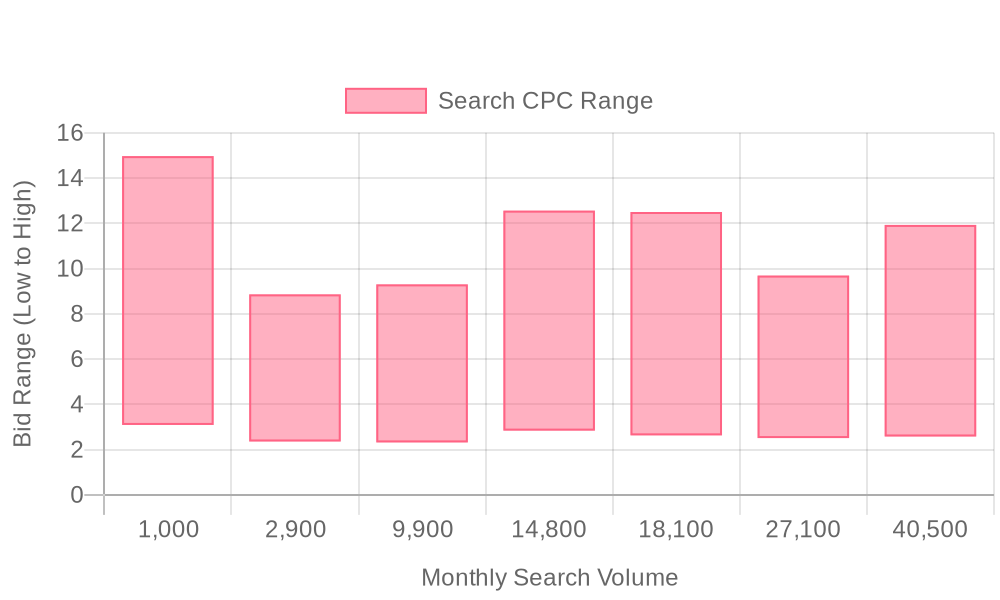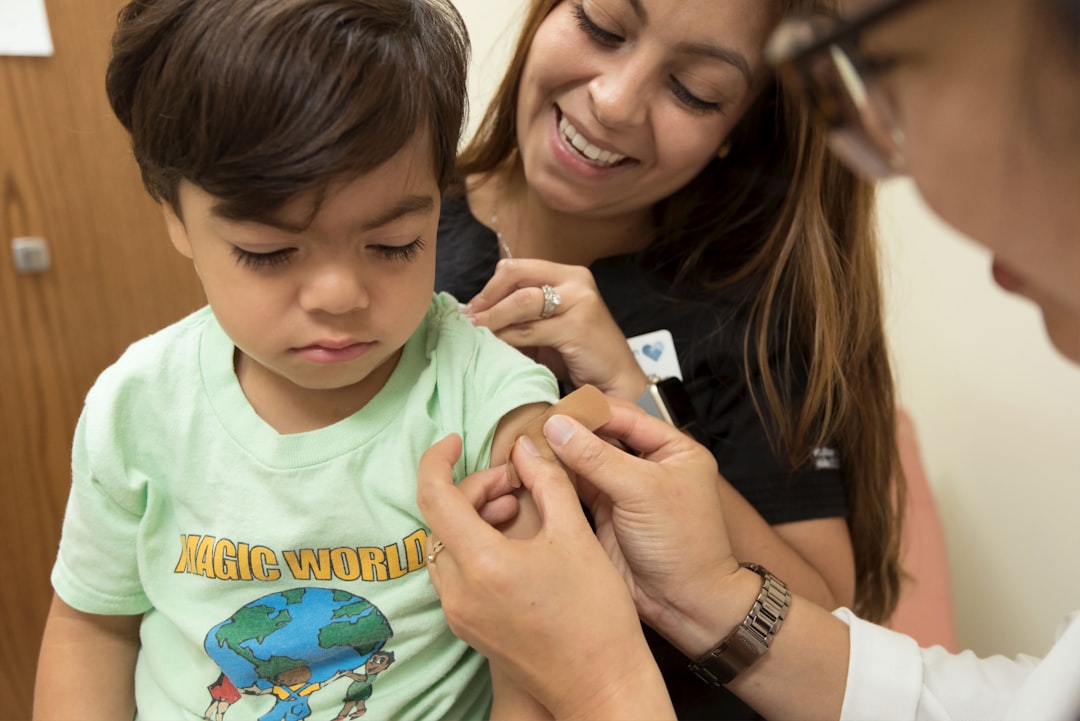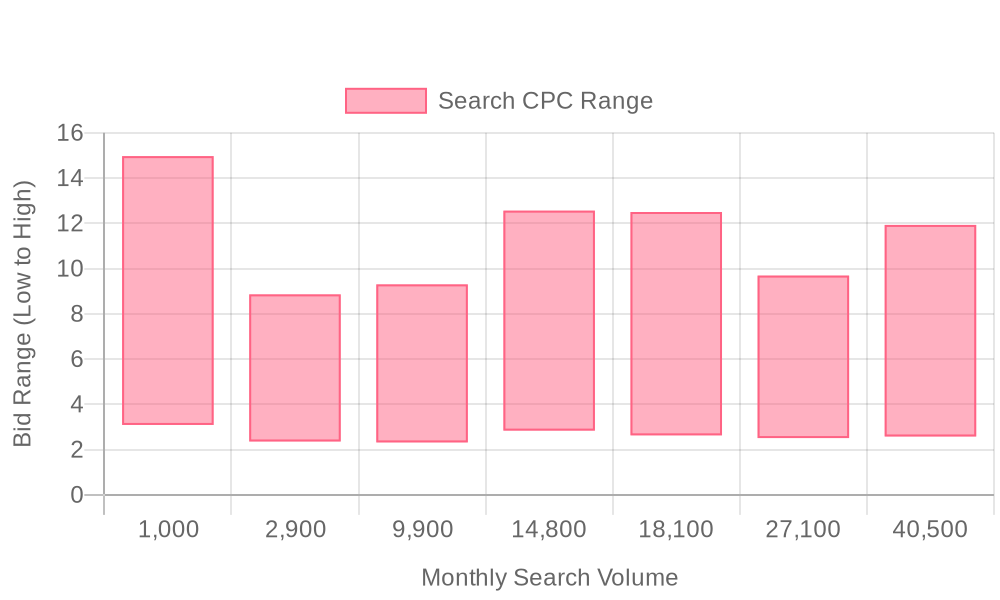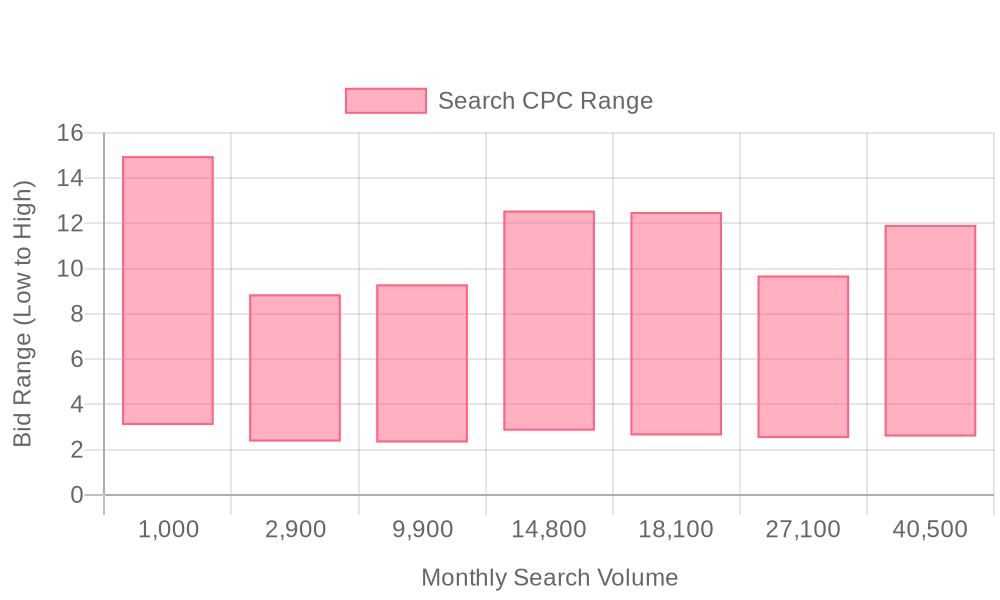
Supercharge your lead generation with a FREE Google Ads audit - no strings attached! See how you can generate more and higher quality leads
Get My Free Google Ads AuditFree consultation

No commitment
Supercharge your lead generation with a FREE Google Ads audit - no strings attached! See how you can generate more and higher quality leads
Get My Free Google Ads AuditFree consultation

No commitment
In today's dynamic marketing landscape, reaching parents seeking infant child care services requires a strategic blend of online advertising platforms. Google Ads is a powerful tool that helps bridge the gap between digital visibility and real-world service engagement. For businesses in the infant child care industry, Google Ads offers a unique opportunity to connect with parents precisely when they're searching for childcare solutions, thus enhancing both visibility and trust.

Driving high-quality leads for infant child care through Google Ads requires a nuanced approach that aligns campaign structure, audience targeting, and creative assets with the unique needs of parents seeking trusted providers. Modern marketers gain a competitive edge by leveraging intent signals and data-driven insights to connect with families at the precise moment they are considering enrollment.
Effective paid search tactics for infant child care move far beyond generic strategies. Campaigns tailored to this segment capture parental attention by using high-performing childcare keywords for PPC, ad extensions, and messaging that address safety, certifications, and proximity—key decision drivers for families with infants.
Ready to attract more high-quality infant child care leads? Get started for free with Sona.

New parent decision cycles are compressed, requiring real-time engagement and tailored messaging to capture high-value infant care enrollments as soon as intent surfaces. Google Ads empowers childcare providers to intercept these high-intent moments, ensuring their services appear precisely when parents are evaluating infant daycare options and ready to act. For a step-by-step guide on optimizing campaigns, explore how to set up Google Ads for childcare services.
Timely campaigns eliminate the lag between inquiry and response, especially crucial for infant child care where safety and trust are paramount. With advanced targeting, marketers can reach parents actively searching for infant care, segmenting by newborn age brackets, location, and lifestyle, while dynamically updating audiences as parents progress through research and enrollment phases.
Regional outreach strategies allow providers to spotlight their services in untapped neighborhoods and emerging communities, driving consistent lead flow even in competitive or underserved markets. By leveraging granular firmographic data, campaigns adapt to local demand shifts and pinpoint areas with the greatest revenue potential.
Analytics integration ensures that every advertising dollar is measured against lead quality, not just clicks or impressions. Marketers can identify not only which ads generate inquiries, but also which companies engage most with infant care content by utilizing website visitor intelligence, supporting continuous optimization and budget efficiency.
Rapid response capabilities are key in an environment where urgency drives action. Real-time audience updates and seamless CRM-ad platform integration enable teams to immediately engage qualified leads—routing high-intent inquiries to enrollment staff, automating nurture sequences, and closing gaps between digital interest and offline tours or signups.
As a result, Google Ads for Infant Child Care provides the infrastructure for data-driven childcare marketing strategies, supporting business growth through targeted parent outreach, measurable ROI, and the agility to respond instantly to shifting demand. To experience these capabilities firsthand, get started for free with Sona.

Ready to optimize your Google Ads for infant childcare? Get started for free with Sona.

Maximizing growth in the infant child care sector requires a proactive approach to uncovering new lead sources and engaging families at pivotal decision points. Success hinges on evolving beyond standard channels and leveraging data to reveal untapped opportunities for targeted, high-quality engagement.

Precise audience segmentation is fundamental to high-performing childcare marketing. When each campaign speaks directly to a distinct group, conversion rates climb and cost per lead drops. This approach reduces wasted spend by ensuring ads reach parents who are actively searching for infant care or specialized childcare services, not just generic audiences. For additional strategies on boosting visibility and leads, see maximizing your daycare’s visibility with Google Ads.

| Industry | Keyword | Monthly Search Volume | Competition Level | Low Bid | High Bid |
| Infant Child Care | best infant daycare near me | 1000 | MEDIUM | 3.09 | 14.97 |
| Infant Child Care | infant child care | 2900 | LOW | 2.36 | 8.86 |
| Infant Child Care | infant care | 9900 | LOW | 2.32 | 9.3 |
| Infant Child Care | infant care near me | 14800 | MEDIUM | 2.84 | 12.56 |
| Infant Child Care | infant child care near me | 18100 | MEDIUM | 2.63 | 12.5 |
| Infant Child Care | infant daycare | 27100 | LOW | 2.51 | 9.69 |
| Infant Child Care | infant daycare near me | 40500 | MEDIUM | 2.58 | 11.93 |
Modern infant child care providers know that keyword strategy is the gateway to capturing parents actively searching for trusted daycare and specialized baby care. By targeting granular, intent-driven search terms, brands can intercept decision-makers precisely when their need is urgent and their likelihood to convert is highest. This approach eliminates wasted spend, guiding every advertising dollar toward audiences who signal readiness for enrollment or inquiry. Discover high-performing childcare keywords for PPC to refine your targeting and maximize campaign efficiency.
By anchoring childcare marketing strategies in high-intent, relevant search terms and leveraging unified data platforms, providers can accelerate business growth and maximize every opportunity to connect with discerning parents seeking infant care solutions. To experience these capabilities first-hand, get started for free with Sona and transform the way you reach and engage your ideal audience.
Precision and intent-driven execution define successful Google Ads for Infant Child Care. Revenue leaders in this sector recognize that blending first-party data with real-time behavioral signals elevates both outreach and conversion efficiency while minimizing wasted spend.
A comprehensive keyword strategy forms the backbone of effective infant care advertising. Begin by categorizing keywords according to core services, such as "infant daycare," "newborn care," and "safe infant environment." Incorporate city and neighborhood modifiers to localize exposure, ensuring parents searching in specific geographies discover your services first. For inspiration on high-performing childcare-related keywords, review this list of childcare keywords for PPC. Long-tail and question-based queries, like "best infant daycare near [city]" or "is your daycare safe for newborns," help capture parents with specific concerns or high-intent needs. Aligning keyword sets with content marketing ensures ad messaging and blog resources reinforce each other, leading to higher on-site engagement and trust. Using platforms that unify visitor identity data, marketers can tie anonymous search clicks to known parent accounts, enabling precise retargeting and optimizing spend on keywords that drive real conversions.
Ad copy for infant care must balance clarity, reassurance, and immediacy. Highlighting caregiver qualifications, such as state licensure or infant CPR certifications, establishes trust from the first impression. Incorporate service differentiators directly in headlines and descriptions, such as "Staffed by Licensed Infant Caregivers" or "24/7 Video Access for Peace of Mind." For a detailed PPC strategy guide, refer to this daycare facility PPC Google Ads strategy. Calls-to-action should be direct and actionable: "Schedule a Tour Today" or "Secure Your Infant’s Spot." Special offers, like "First Month Free Trial," can create urgency for parents evaluating multiple centers. By leveraging real-time audience insights, marketers can dynamically adjust ad messaging to reflect current parent concerns or trending safety topics, ensuring relevance and resonance with each prospect.
High-converting landing pages for infant care are meticulously aligned to the intent of each ad group. Each page should immediately confirm the visitor’s needs with clear headlines such as "Trusted Infant Daycare in [Neighborhood]." Service differentiators, including unique safety protocols, staff-child ratios, and client testimonials, must be prominently displayed to build credibility and lower decision barriers. Trust badges and parent reviews reinforce confidence in your facility’s standards. To explore additional advertising tactics, review these daycare advertising strategies. Calls-to-action need to be unmistakable and optimized for mobile, guiding parents from interest to inquiry in as few steps as possible. With unified data systems, landing page experiences can be personalized to past visitor interactions, showing tailored content for returning parents or those who previously requested information, thus increasing conversion efficiency.
Continuous optimization transforms good campaigns into high-performing growth engines. Monitor both micro-conversions, such as schedule-a-tour form fills, and macro-conversions, like completed enrollments, to measure true marketing effectiveness. Performance analytics should inform creative, audience, and budget decisions across all digital channels. Real-time syncing of enriched audience data ensures that Google Ads retargeting lists always reflect the most current parent interest levels and lifecycle stages. Advanced attribution connects online ad interactions to offline enrollment events, providing a comprehensive view of ROI and enabling informed reallocation of spend toward the channels and campaigns that drive the most valuable outcomes for your childcare business. Get started for free with Sona.
Building a dominant presence in the infant child care market through Google Ads relies on understanding parent motivations and addressing their nuanced decision-making journey. Smart marketers harness actionable data and advanced segmentation to ensure every campaign dollar reaches families that fit their ideal client profile. For additional strategies on increasing your daycare’s visibility and leads through optimized Google Ads campaigns, explore this guide.
Navigating the competitive landscape of Google Ads for infant child care demands a blend of strategic audience building, creative optimization, and seamless data integration. Achieving alignment between your Google Ads execution and the larger lifecycle marketing ecosystem ensures you capture more qualified leads, deliver personalized engagement at scale, and consistently meet the expectations of discerning parents in the infant care market. To see how seamless data integration can elevate your marketing, get started for free with Sona.

In today's dynamic marketing landscape, reaching parents seeking infant child care services requires a strategic blend of online advertising platforms. Google Ads is a powerful tool that helps bridge the gap between digital visibility and real-world service engagement. For businesses in the infant child care industry, Google Ads offers a unique opportunity to connect with parents precisely when they're searching for childcare solutions, thus enhancing both visibility and trust.

Infant child care providers face a highly competitive market where trust, local visibility, and speed to lead define enrollment outcomes. A well-executed Google Ads strategy can become the cornerstone of predictable lead flow, empowering teams to capture parents’ attention at the exact moment of intent. For a step-by-step walkthrough of launching and optimizing Google Ads for childcare services, explore this guide on Google Ads for childcare services.
Adopting a data-driven approach ensures that every campaign element—from keyword curation to audience segmentation—directly aligns with the distinct needs of parents searching for infant care. This not only improves lead quality but also helps teams allocate budget toward the highest-converting opportunities, elevating both marketing ROI and operational efficiency. To further enhance your marketing analytics and campaign effectiveness, visit the Sona blog for actionable insights.
Best practices include using high-performing childcare keywords, ensuring ad and landing page consistency, leveraging real-time signals for audience targeting, and continuously optimizing campaigns with advanced conversion tracking.
Effectively target parents by using high-intent keywords, precise audience segmentation based on behavioral data, and integrating CRM data to build dynamic audience lists that update as parents progress from research to inquiry.

The budget allocation should focus on high-performing keywords and audience segments that drive actual enrollments, with continuous optimization based on conversion tracking to ensure efficient use of funds.
Use high-intent keywords such as 'infant daycare near me' and 'certified newborn care,' and consider long-tail and question-based queries to capture parents with specific concerns or high-intent needs.
In today's dynamic marketing landscape, reaching parents seeking infant child care services requires a strategic blend of online advertising platforms. Google Ads is a powerful tool that helps bridge the gap between digital visibility and real-world service engagement. For businesses in the infant child care industry, Google Ads offers a unique opportunity to connect with parents precisely when they're searching for childcare solutions, thus enhancing both visibility and trust.
Measure success by implementing advanced conversion tracking and attribution to connect online inquiries and offline enrollments, ensuring a closed-loop view of ROI and enabling informed budget reallocation.

Infant child care providers face a highly competitive landscape where every lead represents a family seeking safety, reliability, and trust. Data-driven Google Ads campaigns allow organizations to reach parents at the precise moment they are searching for infant care solutions, capturing attention before competitors even enter the consideration set. For an in-depth, step-by-step approach to optimizing Google Ads for daycare, refer to this comprehensive Google Ads playbook for daycare facilities.
By focusing on these foundational elements, infant child care providers can build a resilient marketing engine that not only drives high-quality lead generation but also adapts to changing parent expectations and local market dynamics. Ready to streamline your lead generation? Get started for free with Sona.
Precision marketing in this sector requires segmentation strategies that reflect the nuances of infant care needs, geographic preferences, and parental priorities. By leveraging real-time audience segments and unified data flows, marketers can nurture higher-quality leads, accelerate the buying journey, and convert intent into lasting enrollment. Explore more actionable demand generation techniques in our marketing playbooks.
Infant child care providers operate in a highly competitive and trust-driven environment, where every new parent is looking for immediate, safe, and reliable solutions. Google Ads for Infant Child Care provides a direct channel to engage these decision-makers at the exact moment they express intent, allowing providers to capture high-value leads before they turn to competitors.
Ready to turn your website traffic into high-quality childcare leads? Get started for free with Sona.


Infant child care providers face intense competition and must reach parents at decisive moments, often when trust and safety are paramount. Digital advertising unlocks precise avenues to engage new parents as they actively research options, ensuring outreach aligns with real-time demand instead of relying on outdated word-of-mouth or static directories. For a practical breakdown of how daycare centers can maximize their visibility and enrollment through targeted digital campaigns, see this guide to Google Ads for daycares.
Modern infant care providers benefit from a range of Google Ads campaign types designed to capture intent, nurture awareness, and accelerate enrollment decisions. Each campaign format offers a distinct way to reach families at various stages of their search for childcare, supporting a diversified digital acquisition strategy while minimizing wasted spend. By leveraging advanced data insights, marketers identify high-value audiences, streamline nurture flows, and ensure every dollar spent on online advertising for childcare delivers measurable results.
Ready to streamline your infant care marketing? Get started for free with Sona.

Professionals in infant child care need digital campaigns that not only attract but also convert high-intent parents seeking trustworthy services. With the right approach, each Google Ads campaign type can drive measurable results while giving marketers nuanced control over audience targeting, messaging, and attribution. For a deeper dive into PPC strategies tailored to daycare, see this step-by-step guide for daycare facility PPC Google Ads strategy and explore actionable playbooks for demand generation and marketing teams.

Growth in the childcare sector depends on a proactive approach to discovering new lead sources and engaging parents with tailored messaging. Providers who leverage untapped channels and advanced data strategies consistently outperform those relying on static, outdated methods.
Growth-focused childcare businesses use these tactics not only to drive more inquiries but to ensure lead quality and conversion rates steadily improve. Integrating advanced attribution and audience sync capabilities across outreach channels provides a holistic view of campaign performance, helping teams double down on what works and confidently scale their infant daycare marketing strategies. Ready to level up your lead generation? Get started for free with Sona.
Modern childcare marketing demands precision in outreach, as parents expect services tailored to their unique schedules and needs. By leveraging advanced audience segmentation, childcare businesses can move beyond generic messaging and deliver relevant, timely offers that drive both trust and enrollment.

Modern childcare businesses grow when they engage beyond traditional advertising and adapt to evolving parent expectations. Identifying new lead sources requires precision, data-driven audience targeting, and the ability to act on real-time intent signals.

| Industry | Keyword | Monthly Search Volume | Competition Level | Low Bid | High Bid |
| Infant Child Care | best infant daycare near me | 1000 | MEDIUM | 3.09 | 14.97 |
| Infant Child Care | infant child care | 2900 | LOW | 2.36 | 8.86 |
| Infant Child Care | infant care | 9900 | LOW | 2.32 | 9.3 |
| Infant Child Care | infant care near me | 14800 | MEDIUM | 2.84 | 12.56 |
| Infant Child Care | infant child care near me | 18100 | MEDIUM | 2.63 | 12.5 |
| Infant Child Care | infant daycare | 27100 | LOW | 2.51 | 9.69 |
| Infant Child Care | infant daycare near me | 40500 | MEDIUM | 2.58 | 11.93 |
A robust keyword strategy for Google Ads for Infant Child Care ensures that ad spend directly fuels enrollment growth and revenue. By focusing on high-intent, location-specific terms, marketers reach families actively searching for trusted infant care solutions, maximizing every impression and click. For a detailed list of effective keywords designed to boost your childcare center’s homepage SEO and increase website traffic, visit this list of effective keywords. Marketers ready to build real-time, signal-based segments that auto-sync with ad platforms can leverage Sona’s Audiences tool for hyper-targeted campaigns.
Growth-focused childcare marketers move beyond one-size-fits-all tactics by leveraging unified data, real-time behavioral signals, and audience synchronization. By continuously refreshing your outreach based on emerging trends and verified intent, your lead generation engine becomes both agile and highly effective, driving steady increases in qualified enrollments and long-term business value. Ready to turn more website visitors into enrolled families? Get started for free with Sona.

**Precision Targeting**: Effective infant care advertising hinges on capturing parents and guardians precisely as they begin searching for child care options. Leveraging intent-based audience lists—such as families with newborns or parents seeking infant daycare nearby—lets marketers serve ads at the peak moment of demand. Real-time behavioral signals, including recent site visits or form completions, enable marketers to dynamically refine audience segments, ensuring ad budgets are dedicated to those most likely to convert. With unified go-to-market data, teams can pinpoint the companies and individuals behind each click by using Sona Identification, moving beyond anonymous impressions to actionable insights. Explore additional tactics for enhancing cold outreach with website visitor intelligence.
Precise audience segmentation is fundamental for driving measurable results in childcare marketing. Modern providers achieve stronger engagement and higher ROI by moving beyond broad messaging to deliver tailored experiences for every parent persona. Data-driven segmentation ensures each campaign resonates with the evolving needs of families seeking infant or toddler care, while industry-specific Google Ads strategies for daycare offer actionable frameworks for effective outreach.
**Measurable ROI**: Success in online advertising for childcare services depends on the ability to track a parent’s journey from first search to enrollment. Precision keyword mapping like "affordable infant care near me," "licensed newborn daycare," and "trusted baby care providers" drives engagement that is immediately measurable. Advanced attribution, including tying digital interactions to offline enrollments and calls, allows teams to optimize spend, eliminate waste, and double down on channels that deliver measurable ROI. By syncing enriched audience and lead data into platforms like Google Ads and CRM systems, marketers ensure every touchpoint is attributed, and every dollar is accounted for. Marketers can track and optimize every stage of the journey with Sona Buyer Journeys and learn more about maximizing ROI through offline attribution.
**Channel Synergy**: Integrating Google Ads for childcare with broader digital campaigns—across display, video, and social—amplifies reach while maintaining message consistency. Retargeting parents who have visited the website, viewed a virtual tour, or engaged with content ensures that no high-value prospect is lost in the funnel. With dynamic audience updates, segments automatically reflect the latest behavioral and intent data as families progress from research to inquiry. This enables marketers to deliver increasingly relevant messaging, nurturing intent and accelerating conversion. Utilize Sona Destinations to automatically sync quality audience data across your CRM, ad platforms, and other GTM tools, and access actionable playbooks for demand generation and sales enablement.
Sample target terms for Google Ads for Infant Child Care include:

Modern revenue teams in the childcare industry require a keyword strategy that delivers precision and measurable impact at scale. For infant child care providers, Google Ads unlocks the ability to engage high-intent parents at the exact moment they are searching for trusted, local solutions—resulting in efficient budget utilization and rapid lead acquisition. For a practical guide, explore how daycare centers can use Google Ads to increase visibility.
A carefully structured multi-channel approach begins with keyword research that maps to the real questions and pain points of parents. Terms such as "Google Ads for Infant Child Care," "affordable infant care near me," "trusted baby care providers," and "licensed infant daycare in [city]" consistently attract parents who are actively evaluating options for their most critical childcare needs. By focusing budgets on these high-intent, location-specific phrases, marketers ensure their ads surface for the most likely-to-convert decision-makers. Audience lists built around these keywords can be enriched and continuously updated as parents move through the research and enrollment funnel, allowing teams to dynamically retarget and nurture prospects with personalized messaging across search, display, and even social channels.
Precision targeting in Google Ads campaigns for infant child care hinges on more than keyword selection. Revenue teams can now go beyond anonymous website traffic by pinpointing which companies and individuals engage with specific infant care content. This identification enables real-time audience enrichment—feeding behavioral signals directly into campaign targeting criteria. When a parent visits a landing page for infant care programs or requests information, their engagement can trigger inclusion in dynamic audience segments, ensuring that remarketing and follow-up touches are always relevant and timely.
The result is full-funnel, data-driven childcare marketing strategies that deliver measurable ROI. Teams can track the true impact of every click and conversion, including offline actions like scheduled tours or phone inquiries, and refine their keyword lists to double down on the terms that drive actual enrollments. With continuous intent monitoring, budgets shift automatically to the highest-performing accounts, and enriched audiences flow seamlessly into CRM and ad platforms—powering smarter, faster, and more profitable campaigns across every stage of the parent decision journey. To see these strategies in action, get started for free with Sona.
Successful Google Ads for Infant Child Care campaigns depend on a disciplined, data-centric workflow that aligns targeting with real-time audience needs and maximizes every marketing investment. Modern revenue teams achieve the strongest results by connecting granular keyword targeting, compelling creative, and adaptive optimization—all underpinned by unified go-to-market analytics. To expand your expertise on PPC strategies for daycare, review this step-by-step guide for daycare facility PPC, or browse actionable tips in our collection of marketing playbooks.
Begin by categorizing keyword lists according to core services such as infant care, safe environments, and tailored developmental programs. Incorporate city or neighborhood modifiers, like “infant daycare in [City]” or “baby care near [Neighborhood],” to ensure hyper-local intent and drive in-market parents to your ads. Utilize long-tail and question-based queries, for example, “Is there licensed infant daycare nearby?” to attract parents searching with specific needs or concerns. Sync these keyword lists with content marketing topics to maintain messaging consistency and increase quality scores across channels. Solutions that reveal which companies are visiting your website and intent signals behind web searches give marketers the edge to prioritize the highest-converting search terms, so teams can confidently expand into new micro-segments as audience insights evolve.
Construct ad copy that emphasizes the expertise and credentials of your infant care staff, such as “Certified infant caregivers” or “State-licensed infant daycare.” Use direct calls-to-action like “Visit Our Licensed Daycare Centers for Infants” to guide parents toward the next step. Drive urgency and engagement by weaving in limited-time offers, such as “First Month Free Trial for New Families.” Dynamic audience segmentation allows you to automatically update ad messaging for parents as they progress from initial research to requesting tours, ensuring that every touchpoint is relevant and persuasive. By leveraging real-time in-market behavior, your campaigns can shift budget toward high-converting parent segments, maximizing impact during enrollment season.
Monitor campaign performance at both micro and macro levels, tracking actions like form fills, calls, and scheduled tours alongside broader trends in click-through and conversion rates. Utilize conversion tracking to tie enrollments directly to ad spend, enabling precise measurement of ROI for each keyword, ad, and audience segment. Feed these insights back into your content and paid media strategies to fine-tune messaging, landing page design, and bid adjustments. CRM and ad platform integrations let you sync enriched parent audiences and lead data, keeping targeting lists current and ensuring remarketing stays focused on the most promising prospects. This closed-loop optimization creates a virtuous cycle, driving continuous improvement across all childcare marketing strategies. To experience these capabilities firsthand, get started for free with Sona.
Effective online advertising for childcare has evolved well beyond standard keyword bidding. Today’s top-performing campaigns for infant care rely on unified audience intelligence, precise retargeting, and data-driven content strategies to keep your brand at the forefront of parents’ minds. By aligning every touchpoint, your marketing not only attracts new families but also builds enduring trust in a competitive field. For actionable strategies tailored to daycare and early childhood education, explore this step-by-step guide for daycare facility PPC Google Ads strategy.
These carefully selected keywords ensure that campaigns capture motivated parents at every stage—from initial research to final selection—driving both immediate inquiries and long-term childcare business growth. To see how you can set up your own high-converting campaigns, get started for free with Sona.
Upselling additional services demands more than generic outreach. By segmenting audiences using comprehensive CRM data, campaigns can deliver tailored messaging to families based on their infant’s age, enrollment status, or previous engagement. Seamless CRM and ad platform integration ensures that as a lead progresses from inquiry to enrollment, audience segments and ad creative adapt to reflect their journey. This approach drives higher engagement and conversion rates while optimizing budget allocation—explore best practices for integrating CRM and marketing systems in this detailed guide.
Modern infant child care centers face high competition and discerning parents, making campaign precision essential for business growth. A systematic approach to Google Ads for Infant Child Care increases visibility, builds trust, and streamlines the enrollment journey for families. For a comprehensive walkthrough on launching successful childcare campaigns, review this guide on Google Ads for childcare services.
Forming affiliations with trusted community associations not only elevates brand credibility but also unlocks referral-driven outreach. Embedding your infant care services within established local networks ensures your Google Ads presence is amplified by word-of-mouth and third-party endorsements. These referrals can be tracked and attributed within advanced conversion tracking systems, providing a full picture of campaign ROI—from initial online touchpoint to offline enrollment.
Navigating the competitive field of Google Ads for infant child care requires strategic insight and tailored execution. Smart keyword targeting, impactful audience segmentation, and high-converting creative—supported by real-time data integration—elevate your marketing effectiveness. Aligning Google Ads strategies with your broader marketing ecosystem captures high-intent leads and fulfills parental expectations, fueling childcare business growth in a demanding market. If you’re ready to optimize every touchpoint, get started for free with Sona.
Success in online advertising for childcare starts with a robust keyword strategy. Segment keywords by service line, such as “infant daycare,” “licensed baby care,” and “safe newborn childcare,” to match specific parent searches. Incorporate geographic modifiers—city, neighborhood, or even ZIP code—to attract families searching for convenient, local solutions. Long-tail queries like “best infant daycare with security cameras” or “full-time baby care in [city]” capture high-intent parents and reduce wasted spend. For a curated list of effective childcare keywords to boost your center’s SEO, explore expert recommendations.
When using unified data platforms, marketers can identify website visitors who interact with these keyword-driven campaigns, unlocking details about the companies or individuals researching infant care services. This insight enables teams to move beyond anonymous traffic, focus on high-value prospects, and inform future keyword expansion based on real-time audience behavior.
Ad copy is the first impression for parents evaluating infant daycare options. Highlight essential caregiver credentials, such as “CPR-certified staff,” “background-checked caregivers,” and “state-licensed infant care,” to convey safety and professionalism. Calls-to-action like “Visit Our Licensed Daycare Centers for Infants” or “Book a Free Infant Care Consultation” drive immediate responses. Special offers—“First Month Free Trial” or “No-Obligation Tour”—create urgency and differentiate your center in a crowded market.
Dynamic audience insights allow revenue teams to refresh ad messaging based on engagement trends, highlighting programs or features that matter most to in-market parents. Adjusting creative in real time ensures that ads consistently address the needs and concerns of families as they move toward enrollment. To see a real-world example of effective ad campaigns, review this childcare marketing case study.
Every ad group should direct to a landing page tailored to its intent, reinforcing relevance and continuity for the visitor. Feature unique service differentiators—such as secure entry systems, real-time video feeds, or low caregiver-to-infant ratios—prominently above the fold. Social proof, including parent testimonials, ratings, and accreditations, builds immediate trust. Streamline calls-to-action: “Schedule Your Tour” or “See Available Infant Spots” should be easy to find, mobile-friendly, and quick to complete.
Unified tracking solutions help attribute conversions across online forms and offline visits, providing a full view of which landing page elements drive tour bookings or enrollments. This comprehensive visibility enables rapid iteration of headlines, testimonials, and CTAs based on measured impact, supporting continuous improvement in childcare service promotion. Discover step-by-step strategies for building high-converting daycare PPC landing pages in this daycare PPC strategy playbook.
Continuous performance monitoring ensures campaigns evolve alongside parent expectations and market trends. Track both micro conversions (form starts, info downloads) and macro conversions (tours booked, enrollments secured) to identify bottlenecks and high-performing touchpoints. Use analytics to inform ad creative, audience segmentation, and even broader content strategies.
Platforms that unify CRM data, ad interactions, and website behavior allow teams to sync enriched audiences directly into Google Ads and other marketing tools. As parents engage, dynamic audience rules update in real time—ensuring remarketing efforts target those closest to conversion and budget is shifted to the highest-converting segments. Holistic attribution, spanning online and offline touchpoints, provides true ROI visibility and supports smarter childcare marketing strategies at scale. Get started for free with Sona.
Expanding your digital footprint in infant child care requires more than baseline campaign management. Combining granular targeting with real-time audience engagement ensures your ads reach and resonate with high-intent parents actively seeking trusted care providers. For a comprehensive guide on setting up and optimizing campaigns tailored to this industry, explore this Google Ads for childcare services resource.
In conclusion, effectively utilizing Google Ads for infant child care services is a strategic move to enhance your visibility and attract parents actively seeking quality childcare options. By leveraging targeted advertising strategies, you can ensure that your services stand out in a competitive market, capturing the attention of those who need it most.
Throughout this article, we've explored the unique challenges faced by childcare providers, such as crafting compelling ad copy, selecting precise keywords, and optimizing campaigns for maximum impact. We also discussed solutions that not only improve your advertising efforts but also align them with the specific needs of parents searching for infant care. The key takeaways are centered around creating a well-structured and data-driven approach to your digital advertising strategies.
Imagining the possibilities of reaching more parents and growing your childcare business is not just a dream—it's a tangible outcome within your reach. By implementing the strategies discussed, you're setting the stage for greater engagement and conversion, ultimately leading to a thriving childcare service. Embrace the transformation that a data-backed Google Ads campaign can bring, and take the first steps toward enhancing your service's visibility.
Ready to see how a unified data platform can further streamline your efforts and provide actionable insights? Start for free to experience our platform’s capabilities and elevate your advertising game today.
Best practices include using data-driven paid search tactics, keyword selection focused on high-intent phrases, audience targeting by demographics, consistent landing page and creative alignment, continuous optimization, and cross-channel integration.
These strategies, when backed by unified data and advanced attribution, provide a holistic view of campaign impact. Marketers can identify previously anonymous site visitors, connect in-market signals to specific accounts, and shift budget toward the highest-converting audiences. Elevate your advertising ROI and get actionable insights—get started for free with Sona.
Effectively target parents by using real-time audience segments, demographic filters, and refining reach with keywords that capture parents who are in-market and ready to engage.
The budget should be flexible, allowing for dynamic adjustments as new high-intent accounts are identified, ensuring resources are allocated where they have the most impact.
Use high-intent, location-specific phrases such as 'infant daycare near me,' 'licensed baby care,' and 'newborn care center' to attract parents actively searching for childcare solutions.
Measure success through robust analytics, conversion tracking, and real-time intent signals that inform continuous optimization, analyzing both online and offline conversions.
In the competitive landscape of infant childcare services, leveraging Google Ads effectively can be the key to enhancing visibility and attracting the right clientele. By tailoring your advertising strategies to meet the specific needs of parents searching for infant care, you can create impactful campaigns that resonate with your target audience.
Throughout this article, we've explored the unique challenges of advertising in this niche market, such as targeting the right demographics and crafting compelling ad copy. We've also outlined practical solutions, including optimizing keywords, utilizing geo-targeting, and creating engaging visuals that highlight the nurturing environment of your childcare services.
By implementing these strategies, you have the opportunity to transform your approach to online marketing. These insights not only help in reaching concerned parents but also build trust in your services. Embrace these methods to position your childcare business as a reliable and caring option for parents seeking the best for their infants.
Take the next step towards optimizing your advertising efforts and experience a comprehensive solution that unifies your marketing data. Start for free to explore how our platform can elevate your childcare marketing strategies today.
Best practices include tailoring search strategies to focus specifically on infant care, using advanced keyword research for precise targeting, ensuring landing page consistency, and continuously optimizing campaigns based on performance data.
You can effectively target parents by using highly specific keywords, demographic and location targeting, and integrating audience data from CRM systems to create dynamic, real-time updated audience lists.
The budget should be allocated toward the highest-converting opportunities, focusing on keywords and locations with the highest intent, and continuously optimized based on cost per conversion benchmarks.
Use keywords like 'licensed infant daycare near me,' 'newborn care specialist,' 'affordable infant care near me,' and 'trusted baby care providers' to capture high-intent searches from parents.
Success can be measured by tracking conversions from ad clicks to enrollments using advanced conversion tracking, analyzing cost per conversion, and integrating online and offline engagement data for comprehensive attribution.
Join results-focused teams combining Sona Platform automation with advanced Google Ads strategies to scale lead generation

Connect your existing CRM

Free Account Enrichment

No setup fees
No commitment required

Free consultation

Get a custom Google Ads roadmap for your business
Join results-focused teams using Sona Platform automation to activate unified sales and marketing data, maximize ROI on marketing investments, and drive measurable growth

Connect your existing CRM

Free Account Enrichment

No setup fees
No commitment required

Free consultation

Get a custom Google Ads roadmap for your business
Over 500+ auto detailing businesses trust our platform to grow their revenue
Join results-focused teams using Sona Platform automation to activate unified sales and marketing data, maximize ROI on marketing investments, and drive measurable growth

Connect your existing CRM

Free Account Enrichment

No setup fees
No commitment required

Free consultation

Get a custom Google Ads roadmap for your business
Over 500+ auto detailing businesses trust our platform to grow their revenue
Join results-focused teams using Sona Platform automation to activate unified sales and marketing data, maximize ROI on marketing investments, and drive measurable growth

Connect your existing CRM

Free Account Enrichment

No setup fees
No commitment required

Free consultation

Get a custom Google Ads roadmap for your business
Over 500+ auto detailing businesses trust our platform to grow their revenue
Join results-focused teams using Sona Platform automation to activate unified sales and marketing data, maximize ROI on marketing investments, and drive measurable growth

Connect your existing CRM

Free Account Enrichment

No setup fees
No commitment required

Free consultation

Get a custom Google Ads roadmap for your business
Over 500+ auto detailing businesses trust our platform to grow their revenue
Our team of experts can implement your Google Ads campaigns, then show you how Sona helps you manage exceptional campaign performance and sales.
Schedule your FREE 15-minute strategy sessionOur team of experts can help improve your demand generation strategy, and can show you how advanced attribution and data activation can help you realize more opportunities and improve sales performance.
Schedule your FREE 30-minute strategy sessionOur team of experts can help improve your demand generation strategy, and can show you how advanced attribution and data activation can help you realize more opportunities and improve sales performance.
Schedule your FREE 30-minute strategy sessionOur team of experts can help improve your demand generation strategy, and can show you how advanced attribution and data activation can help you realize more opportunities and improve sales performance.
Schedule your FREE 30-minute strategy sessionOur team of experts can help improve your demand generation strategy, and can show you how advanced attribution and data activation can help you realize more opportunities and improve sales performance.
Schedule your FREE 30-minute strategy session





Launch campaigns that generate qualified leads in 30 days or less.
